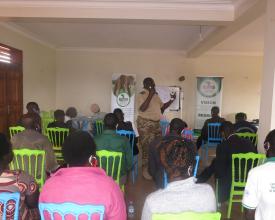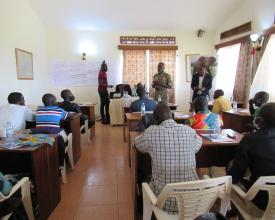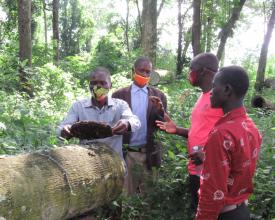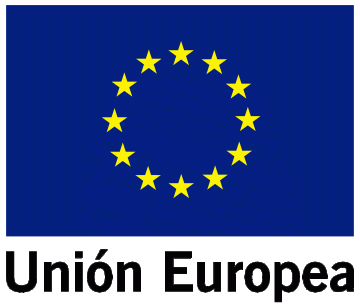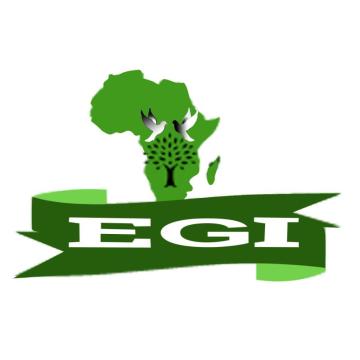
Empowering communities for sustainable alternative livelihoods to cope with Covid-19 crisis

Before the Covid-19 pandemic, over 90 % of the community members, living around the Murchison Falls Protected Areas, made an income from tourism related activities. Even the Uganda State as a whole was relying very much on tourism contributing to 7.9 percent to the GDP in 2019.
As a direct consequence of the tourism shutdown, local villagers went in the Protected Area to hunt for bush meat, find food, cut down tree cover for charcoal and find other resources for income.
The Environment Governance Institute (EGI) team has been working towards sustainably diversifying livelihoods to build resilience among local communities and awareness raising activities, that got eventually a large attention in the media. Thanks to a well-articulated combination of actions and supportive partnerships, local communities were able to overcome the challenges brought by the pandemic and improve their livelihoods, with a highly positive consequence on the Protected Area’s integrity.
Context
Challenges addressed
- Lack of diversified livelihoods for local communities, relying almost only on tourism
- Dramatic increase of encroachment in the Protected Area during the pandemic
- Limited resources from government to respond to encroachment crisis as economy was affected
Location
Process
Summary of the process
On the one hand, local communities, through village champions, were trained and supported to set up households businesses, as bee keepers or commercial farmers, building on what people used to do, but improving the marketing and packaging, as well as the management and the techniques used. It ensured an increase of income, which had a direct effect on reducing greatly poaching in the Protected Area. On the other hand, local communities groups engaged in art activities, spread powerful messages among their peers, to promote conservation. Communities’ bylaws reflect their will to respect the Murchinson Falls Protected Area’s fauna and flora integrity. Additional actors, as diverse as the local authorities, the medias and the Telecom company, all contributed to reinforce the success of the different strategic actions that we implemented.
Building Blocks
Development of diversified livelihoods
EGI conducted a rapid assessment on diversified livelihoods to find out what were local communities already doing.
Bee keeping came out as a common income generating activity, driven by a high demand in honey products. The households’ income has increased through the sale of honey and derived products, such as medicine, bee venom, propolis, wine, cosmetics. This is now cushioning them against climate change impact such as prolonged droughts and floods that have negative impacts on agriculture, hence able to sustain income and their livelihoods which is thus addressing the key drivers of poaching.
Another sector of intervention was agriculture. Local communities were trained to improve the resistance of their crops to climate change.
Enabling factors
Community champions took a leadership role in exchanging with their larger community. They also co-drafted their bylaws with EGI, during community meetings, that mandate people not to trade in any act of poaching, trade-in species or products, illegal entry into the Protected Area. These were the first local regulations ever in the area.
Lesson learned
- Identifying and using community champions model is an effective tool and method for engaging communities to diversify their livelihoods, increase acceptability of the project and attract communities to embrace conservation efforts. This enables rapid adoption of the alternatives livelihoods options.
- Partnerships with the key stakeholders including UWA and district environment and forest officers is very critical for EGI to continue engaging with the communities during the COVID 19 crisis.
- Managing wildlife conflicts and threats like poaching require more community involvement and participation in planning, implementation and designing the end goal, it increases ownership and sharpens effective strategies.
- Conducting community needs assessment to determine the approaches that work with different communities is key to applying tailor made interventions.
- Responding to a conservation crisis requires careful understanding of community needs and using them to model immediate and long term interventions that increase the attachment communities have on wildlife.
Powerful awareness raising approach
EGI partnered with Bunyoro and Bugungu cultural institutions to provide art skills to local people. 20 community groups, including women, youth and girls, formed different drama groups, that perform theatre plays, songs and dances, delivering strong messages, while providing entertainment for local communities. They are so successful that they are now hired at different occasions to perform, which provides also an income to these drama groups. They continued to perform during the second wave of Covid-19, in radio drama programs.
Enabling factors
The partnership with the cultural institutions allowed to develop the cultural approach and adequate messages to support behaviour change among local communities.
Lesson learned
Cultural and religious leaders have great influence on their communities, involving them early in the project design increased the effectiveness of the approache.
Cultural values and customs must be embedded in the project as communities have an aesthetic attachment to it.
Multiple supportive actors
EGI has engaged multiple and diverse actors, to support different and important aspects of the overall strategy. First, the local authorities were key as they provided access to the Protected Area to the EGI team, in times of lockdown and restricted access to transport and places. Second, the local and national medias supported the different activities, by organising talk show to share information and support education and awareness raising efforts. EGI was offered 16 opportunities, to create awareness on the relevance of promoting conservation amidst Covid-19 times in the country. Finally, the Telecom company contributed to solving human – wildlife conflicts, establishing an environmental toll-free line, allowing communities to call EGI and the park rangers, if elephants for example come out of the park, with the risk of damaging their fields. The phone call allows for a quick response, where park rangers bring the elephants back in the Protected Area, avoiding the killing of these animals.
Enabling factors
EGI experienced a significant increase in its visibility and the work it does, at the local and international levels, since it was granted with the IUCN Save Our Species rapid grant and listed on the website. EGI received for example, 18 interview requests from international members who wanted to understand the work, how we do and the impact Covid 19 has had on conservation as well as our response to them. This gave the organization international recognition as the information was accredited to us.
Lesson learned
Partnerships are key with both governement and local communities in response to an emergency situation in conservation.
Impacts
The level of encroachment dropped dramatically from 32 to 6 cases in 12 months.
Diversified livelihoods successfully implemented to support an increased number of community members, e.g. 366 households trained in bee keeping (200 bee hives were provided), 612 community members have adopted improved agricultural land use practices resistant to climate change. The general income of community households have increased and their businesses became also more resilient.
The training and involvement of young people in art performances, to raise awareness on the link between the biodiversity conservation and human livelihoods got the attention from the media. The drama groups are now often hired to perform, as they deliver strong messages on biodiversity benefits and how to live in harmony with wildlife.
The relationship between the local communities and the Uganda Wildlife Authority has improved; the authority uses less the force to reinforce the Protected Areas law.
A set of by-laws to regulate the activities in the Protected Areas were drafted and agreed upon by the local communities and endorsed by the District leaders.
Beneficiaries
- Local communities in the five districts of Hoima, Masindi, Bullisa, Kiryandongo and Kibale around Murchison Falls green belt
- Murchison Falls Protected Area management team
Sustainable Development Goals
Story
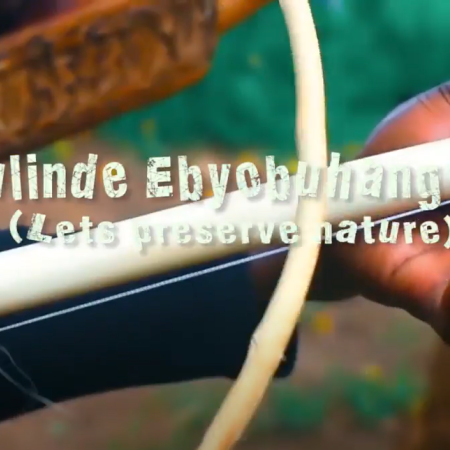
Mr. Kwikiriza Tickey is the lead singer and a chairperson of the Friends of Chimpanzee drama group.
It is located within the chimpanzee corridor connecting Bugoma and Budongo forest reserves within Murchison falls National Park. The group arose out of the need to reverse community revenge on chimpanzees who started invading their settlements destroying crops and homesteads. The communities did not know that their actions of encroaching on the chimpanzees habitat for firewood and building materials were responsible for the negative impact.
The group comprises 25 members (16 males and 11 females) and use primary local tools to generate music, dance and drama to sensitize communities on how to live in harmony with nature. Today, the group’s impact has been powerful in changing the community mindset and enhanced chimpanzee conservation.
Please look at the music clip of their song “Let’s preserve nature” in the video link in the resources below. The lyrics of the song in English are the following:
Let us protect nature and not destroy the environment, it provides for our livelihoods and supports us in different ways.
The forest, lakes, and swamps work together to give us fresh air, the food we eat, and also provide shelter to our ancestors the chimpanzees.
The scholars and researchers said we evolved from chimpanzees that’s why they eat, move, dance, and play like us.
You see how we dance, that’s how they also dance in the forest when they are happy. Don’t destroy their home and make them unhappy. We should protect them as they form our history. We are friends of chimpanzees, forest and other animals.
We should not destroy the forest by cutting down trees because they are also our spiritual home, our parents used to pray in these forests and they got blessings, why should we destroy the things our parents used to treasure.
Even today the trees you are seeing provide us with nice shades, the trees do support us with rainfall formation that we depend on for planting our crops such as Matooke (bananas), sweet potatoes, sorghum.
I have heard people complain that the animals come and destroy our crops and our homes, but it’s because we have destroyed their homes, let’s ensure they have a home and they will not come to our homes.
Nature is so expensive, see if we destroy it but very beautiful if we conserve it.
We have advised you to protect nature, do not destroy the wildlife.
I have advised you all, you also go and tell others. Nature is our livelihood, let’s protect it!

